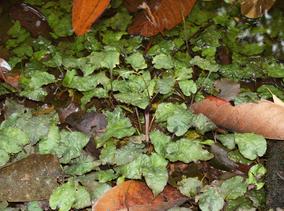Araceae
Cryptocoryne Fisch. ex Wydler
SUMMARY
Laticifers absent in foliage leaves but present in stem, roots and cataphylls (Sivadasan, pers. comm.). HABIT : small or medium-sized herbs, evergreen or rarely dormant in dry season (C. nevillii, C. consobrina), rhizome creeping, stoloniferous. LEAVES : many, cataphylls conspicuous when present. PETIOLE : sheath fairly long. BLADE : ptyxis convolute, cordate, ovate, lanceolate, elliptic, linear, rarely filiform (C. retrospiralis at certain seasons), mostly glabrous, rarely pubescent, sometimes bullate; primary lateral veins pinnate, usually weakly differentiated, running into inconspicuous marginal vein, higher order venation transverse-reticulate. INFLORESCENCE : solitary, usually appearing with the leaves. PEDUNCLE : short, elongating in fruit. SPATHE : tube with connate margins, at base swollen into ellipsoid to cylindric “kettle”, kettle rarely constricted, sometimes alveolar within, entrance with a lateral flap partially or completely covering male zone of spadix, upper part of tube long or short (in some species length depending on water depth), rarely absent (C. spiralis), sometimes widening or narrowing at mouth, blade cordate to lanceolate, erect or reflexed at anthesis, spreading, slightly twisted or long-spiralled, apex cuspidate to long-caudate, inner surface smooth, rough, uniformly warty or with warts in transverse bands, or covered with shortly branched protuberances, white, yellow, red, purple, brown, sometimes spotted, junction with tube usually marked by inconspicuous to very prominent “collar” which normally differs in colour and texture from blade. SPADIX : slender, female zone consisting of a single basal whorl of 4-8 upright gynoecia, with single whorl of rounded, subclavate or irregular olfactory bodies (?pistillodes) usually present immediately above, female and male zones separated by a long naked axis , or rarely fertile zones almost contiguous, male zone ellipsoid to subcylindric, terminal appendix short, conical or irregularly oblong to subclavate, apically adnate to spathe behind flap, often breaking free during anthesis. FLOWERS : unisexual, perigone absent. MALE FLOWER : apparently 1-androus, stamens free, anthers sessile or with short filaments, apex excavated with very prominent, thickened margins, connective inconspicuous, thecae opposite, ending in short to long, attenuate horn usually projecting beyond thickened margins, dehiscing by apical pore. POLLEN : extruded in a droplet, inaperturate, ellipsoid to oblong, medium-sized (mean 34 µm., range 27-42 µm.), exine psilate. FEMALE FLOWER : ovaries connate, 1-locular, ovules 5 to many, orthotropous, funicle short, usually bearing numerous long trichomes extending between ovules, placenta subbasal to obliquely parietal (adaxial, morphologically basal), style free, usually curved away from spadix axis, stigma discoid, rounded or elongated, often emarginate, often centrally concave. FRUIT : connate into an ovoid, smooth to verrucose capsule-like syncarp dehiscing apically at maturity and becoming star-shaped. SEED : ellipsoid-oblong, straight or slightly curved, testa brown, not very thick, rough to slightly costate, or smooth, embryo elongate, straight, endosperm copious; seed sometimes viviparous and then seedling with many filiform cataphylls (C. ciliata).





